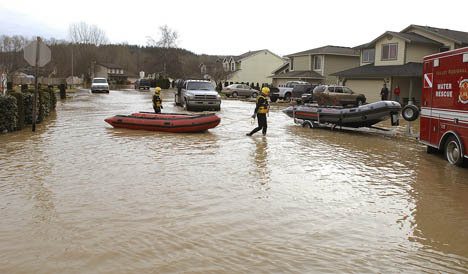Unlike neighboring cities in the valley, Pacific already has waded through insidious, costly flooding.
Last January, an expected but familiar culprit, the White River, spilled floodwaters over its banks into the small city of roughly 6,000 people.
The flood went on to damage more than 110 homes and 10 businesses, leaving behind $15 million in losses. At one point, a fifth of the city’s residents – about 1,200 – had to evacuate their homes and apartments as floodwaters reached 10-feet high.
While everybody learned hard lessons from last winter’s flooding, city officials and residents hope to be better prepared for the next storm season. They are bracing for the worst, yet hoping for the best.
“We don’t expect flooding from the White (River) but if we do, we want to be prepared,” said Mayor Richard Hildreth. “Just let me ask, ‘If people are prepared and it doesn’t happen, will they be disappointed?’ ”
Hildreth, city and public safety officials recently held a town hall meeting to update a crowd of 200-300 on river and levee conditions and explain the improved steps to monitor river conditions.
Mitigation is under way, although it appears proposed levee setback projects are a year off. The city also hopes to lead efforts to scalp the river channel free of debris, sand and gravel deposits as soon as possible.
Hildreth pointed out that the suggested projects, environmentally sensitive or not, will be contingent on permits.
For now, a one-mile stretch of the White River that flows through the city has been the focus. The channel’s capacity isn’t what it used to be, since it hasn’t been dredged in 20 years, Hildreth said.
The river’s reduced capacity may have contributed to flooding, Hildreth said.
Last January, the Army Corps of Engineers released water over the Mud Mountain Dam, built upstream from Enumclaw to control flooding on the Puyallup and White rivers, when the reservoir was near capacity. The release was necessary to ease stress on the earthen dam and to make room for incoming water over the next few days.
The water volume – 11,700 cubic feet per second at its peak during the storm – was the same volume released over the dam in November 2006, when the city last flooded, a Corps spokesman said. But the ’06 flood was considered “nuisance flooding,” not the widespread inundation in January that put the city’s main park and White River Estates under as much as 10 feet of water.
Corps officials said they followed information that suggested that nuisance flooding can start up to 12,000 (cubic feet per second) release, “but nothing significant.”
Still, the waters came.
Hildreth estimated the river has lost about 35 percent of its capacity because of debris buildup in its channel. Until a scalping effort can be approved, that worry still exists, he said.
Well aware of the issues downstream, Corps officials maintain that the dam is sound and ready to handle the demands of a wet season. While repairs go on at nearby Howard Hanson Dam, it will be businesses as usual at Mud Mountain Dam.
Many of the issues Hanson Dam is facing, Mud Mountain Dam has repaired, including the installation of a concrete cutoff wall more than a decade ago.
“Mud Mountain Dam is completely fine. Everything is working well,” said Patricia Graesser, public affairs chief for the Seattle District, Corps of Engineers. “We’ve been working well with the USGS (U.S. Geological Survey) and King County to assess the channel capacity of the White River down by Pacific.”
King County, meanwhile, is being asked to lead the way for appropriate levee setbacks. Such a setback, especially along the eastside of the river, would double the capacity of the river as well as “create a great salmon habitat,” Hildreth said.
The river’s existing levees appear to be in good shape, Hildreth said. In the aftermath of last winter’s flooding, the Corps strengthened and raised the rock wall along the river.
“Most of the critical areas have been armored with concrete and asphalt pavement to protect the levee from washing out,” Hildreth said.
In addition, Hildreth said that Corps, county and city officials are working together to improve communications in monitoring river conditions. While the Corps accepted blame for releasing too much water from a full dam, there were communication breakdowns among emergency personnel at the local, regional and federal levels, a Corps report said.
The city and its residents, meanwhile, are asked to do their part. The city will have pre-staged sandbags handy and available to businesses and property owners, Hildreth said.
Business, home and property owners also are urged to immediately buy flood insurance.


